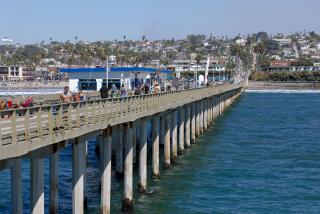Short-Term Dredging of Marina OKd : Environment: Silt will be pushed offshore until plan for removal is approved.
- Share via
WASHINGTON — Federal and Los Angeles County officials agreed Thursday to temporary measures for clearing silt that has dangerously narrowed the entrance channel to Marina del Rey.
The “knock-down dredging” would push the sediment into deeper water until long-delayed permanent dredging can be performed. It should provide about six months of relief, said Ted Reed, the county’s director of beaches and harbors.
“We have solved the short-term problem,” Sen. John Seymour (R-Calif.) said after meeting with officials of the Environmental Protection Agency, the Army Corps of Engineers and the County Department of Beaches and Harbors. But the permanent dredging of the marina, he added, is “crucial and critical to the protection of human life.”
Recreational boaters and rescue crews are endangered by increasingly narrow access to the marina’s two entrances, county officials say. The marina is home to more than 6,000 recreational craft and 13 rescue vessels and it figures prominently in sea rescue plans for Los Angeles International Airport.
The marina’s south entrance is 70% closed and its north entrance is 40% closed because the water is less than 12 feet deep, according to the sheriff’s harbor patrol.
The temporary dredging will not start until late August, well into the busy summer season. Until then, Reed said, the harbor patrol may have to limit the number of boats on the waterway.
Permanent dredging was scheduled to start in late 1991 but tests for pollutants have caused delays. Dredging cannot begin until county authorities know whether the silt is free of pollution. If it is toxic, it must be disposed of under state and federal safety standards.
The federal government will pay for dredging, but the county, which owns and operates the harbor, will foot the bill for disposal of any contaminated materials that cannot be dumped on the beach or in the ocean. Seymour and Reed said they hope uncontaminated silt can be separated and disposed of in the ocean or used as replacement sand for surrounding man-made beaches.
Federal officials agreed Thursday to retest the silt for contamination. Earlier tests found the sediment was unsafe for offshore disposal, but some of those tests have been dismissed as flawed.
County officials estimate that disposing of toxic residue could cost $40 million, but Roger Gorke of Heal the Bay called the figure “extremely inflated.”
More to Read
Sign up for Essential California
The most important California stories and recommendations in your inbox every morning.
You may occasionally receive promotional content from the Los Angeles Times.













